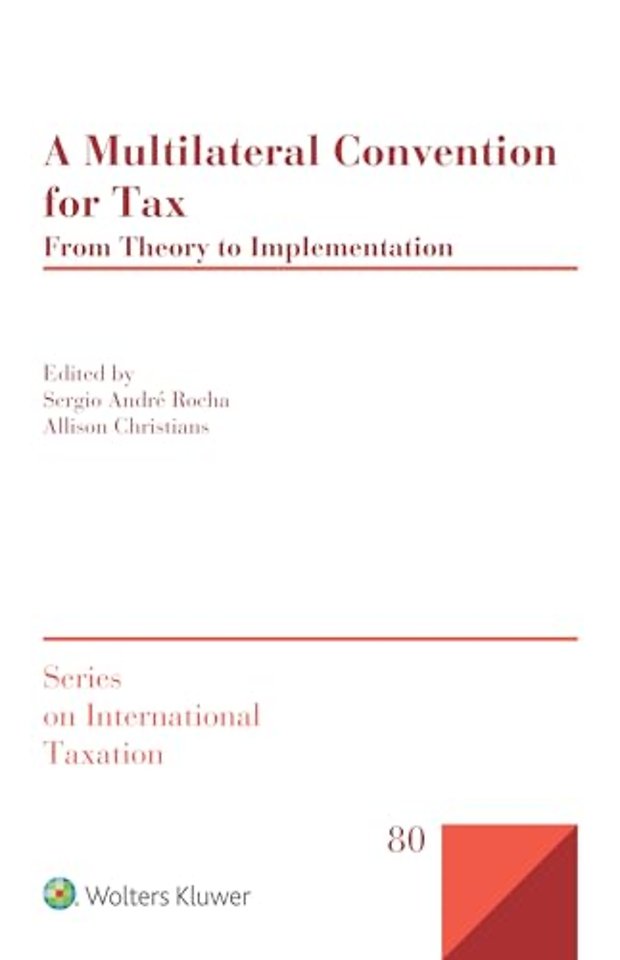A Multilateral Convention for Tax
From Theory to Implementation
Samenvatting
Series on International Taxation Volume 80
A Multilateral Convention for Tax is a pioneering book that assesses a pivotal and revolutionary paradigm shift in the Multilateral Convention to Implement Tax Treaty Related Measures to Prevent Base Erosion and Profit Shifting (MLI) versus a mechanism that primarily continues an ongoing flow of limited policy coordination—two radically opposed viewpoints on the convention—with thorough analyses that kindle the hopes and the realities of the current era of multilateral tax cooperation. Since the advent of modern income taxation over a century ago, the MLI has been the most dynamic multilateral initiative coordinating tax regimes on a global basis.
What’s in this book:
Uniting the efforts of authors from national jurisdictions worldwide to scrutinize the MLI and its likely future ramifications, the book furnishes an in-depth commentary and analysis in the following sequence:
- first, a comprehensive discussion of the design and goals of the MLI as a treaty and an institutional framework;
- second, an overview of the structure of the convention and its take-up across the globe to date; and
- third, the substantive implementation of the MLI with a wide range of country reports.
Practice areas covered include tax law, international law, and international relations.
How this will help you:
The legal workings and implications of the MLI might still seem like a mystery to those whose day-to-day work is impacted by it, and as yet, little jurisprudence regarding its legal nature or ultimate effect on the bilateral treaties is coming within its scope. Consequently, this trailblazing book will be highly appreciated by in-house counsel and law firms advising cross-border investors and firms; nongovernmental organizations involved in policy analysis and issue advocacy; researchers working on technical areas of international tax law; and lawyers interested in international policymaking, including the creation and diffusion of consensus-based fiscal and related regulatory norms across jurisdictions of different development levels.
Specificaties
Inhoudsopgave
Contributors
Introduction
Allison Christians
PART I
The Purpose, Nature, and Significance of the MLI
CHAPTER 1
Multilateralism, Multilateralism, Who Is Sovereign after All? Tax Sovereignty after BEPS Multilateral Instrument
Rita Calçada Pires
CHAPTER 2
The Multilateral Convention from a Public International Law Perspective
Vanessa Arruda Ferreira
CHAPTER 3
Is the Multilateral Instrument Really Multilateral?
Nathalie Bravo
CHAPTER 4
Risk Society and International Tax Multilateralism
Sergio André Rocha
PART II
Structure and Adoption
CHAPTER 5
The Framework of the Multilateral Instrument
Ramon Tomazela Santos
CHAPTER 6
MLI Implementation and Impact from the Latin American Perspective
Andrea Laura Riccardi Sacchi
CHAPTER 7
A Cross-Jurisdictional Analysis of MLI Implementation to Date
Natalia Pushkareva
PART III
Implementation in Practice: Precedents, Challenges, and Prospects for Uniformity
CHAPTER 8
Domestic and Treaty-Based GAAR and SAAR: Potential Conflicts and Ordering Principles MLI and Argentine Treaty and Domestic Law
Guillermo O. Teijeiro
CHAPTER 9
The DNA of the Principal Purpose Test in the Multilateral Instrument
Marcus Livio Gomes
CHAPTER 10
Virtual PE Concept and the Challenges of a Multilateral Solution
Michell Przepiorka & Gisele Barra Bossa
CHAPTER 11
From Bilateralism to Multilateralism: Is This Shift Beneficial for Developing Countries? A Focus on 7(1) MLI
Ricardo García Antón
CHAPTER 12
Aggressive Tax Planning and Its Interaction with the MLI
Cristián Billardi
Index







